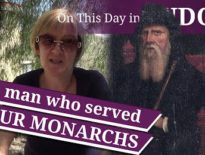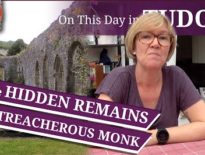On this day in Tudor history, 13th March 1540, sixty-eight-year-old Henry Bourchier, 2nd Earl of Essex, died after suffering a broken neck in a horse-riding accident. Chronicler Charles Wriothesley recorded: "the Earl of Essex, riding a young horse, by misfortune cast him and brake his neck at his place in Essex, which was great pity."
Henry Bourchier, 2nd Earl of Essex, was related to the royal family and served both Henry VII and Henry VIII. Find out more about this Tudor man in today's talk.
Also on this day in Tudor history, 13th March 1601, Henry Cuffe and Sir Gelly Meyrick were hanged at Tyburn for their part in the disastrous Essex's Rebellion of February 1601. You can find out more about them and what happened in last year’s video:
Also on this day in history:
- 1543 – Death of Sebastian Giustinian, the Venetian diplomat. He died in Venice at the age of eighty-three. Giustinian served as the Venetian ambassador to England from 1514 to 1519, and wrote 226 letters during his embassy there. He became ambassador to France in 1526 and procurator of St Mark in 1540.
- 1594 – Death of John Woolton, Bishop of Exeter, from asthma at the bishop's palace in Exeter. He was buried in the cathedral choir.
- 1619 – Death of Richard Burbage, actor and star of Shakespeare's Lord Chamberlain's Men and the King's Men. He was named in Shakespeare's will of 1616 as a "fellow", meaning a close friend or colleague.
Transcript:
On this day in Tudor history, 13th March 1540, sixty-eight year-old Henry Bourchier, 2nd Earl of Essex, died. Contemporary historian John Weever, in his book “Antient Funeral Monuments”, explained that Essex died after breaking his neck in a fall from a horse. Weever quotes his fellow historian John Stow as saying, “the horse was young, and he the oldest earl in England”. Chronicler Charles Wriothesley recorded “the Earl of Essex, riding a young horse, by misfortune cast him and brake his neck at his place in Essex, which was great pity.”
Let me tell you a few facts about this Earl of Essex:
• Essex was born in 1472 and was the son of Sir William Bourchier and his wife, Anne Woodville, daughter of Richard Woodville, Earl Rivers, and sister of Elizabeth Woodville, queen consort of King Edward IV.
• His great-uncle was Thomas Bourchier, Archbishop of Canterbury.
• In 1483, he inherited the earldom of Essex following the death of his grandfather, Henry Bourchier, 1st Earl of Essex, because his father was already dead by this time.
• His family links with Elizabeth of York meant that he was an important man in the court of King Henry VII, taking an active part in state occasions, like Henry VII’s coronation and Elizabeth of York’s funeral. He also supported the king in a military sense, fighting in France in 1492 and against the Cornish rebels in 1497. He was rewarded for his loyal service with grants of land. He was also elected as a Knight of the Garter.
• In 1497, a marriage contract was arranged for Essex to marry Mary Say, daughter and co-heir of Sir William Say, and the couple married soon after. They had a daughter, Anne. Mary died sometime between 1535 and 1540.
• After Henry VIII’s accession in 1509, Essex was made captain of the king’s spears, and then, in 1511, he was made Constable of Windsor Castle.
• Essex was active in Henry VIII’s French campaign in 1513, providing over 400 men and leading a cavalry charge. He attended the historic Field of Cloth of Gold in 1520, acting as marshal of the English party.
• He was excused from missing sessions of Parliament in the 1530s due to his deafness and declining health, although he still hunted and was able to travel between his properties. He also started missing chapters of the Order of the Garter.
• In 1533, he was well enough to serve as a carver at Anne Boleyn’s coronation banquet, to lead the mourners at the funeral of Mary Tudor, Queen of France, and to carry the basins at the baptism of Princess Elizabeth. In 1537, he attended Prince Edward’s christening, and in January 1540 attended the reception of Anne of Cleves.
• In December 1539, he was well enough to help oversea the trial of the Abbot of Colchester.
• Essex died on this day in 1540 without a son to inherit his earldom. His daughter, Anne, and her husband, Sir William Parr, inherited his estates and in April 1540 the earldom of Essex was granted to Thomas Cromwell, who was executed just three months later. William Parr was granted the earldom in 1543 following the marriage of his sister, Catherine Parr, Lady Latimer, to the king
• Essex was buried at Little Easton in the Church of St Mary the Virgin.



Leave a Reply